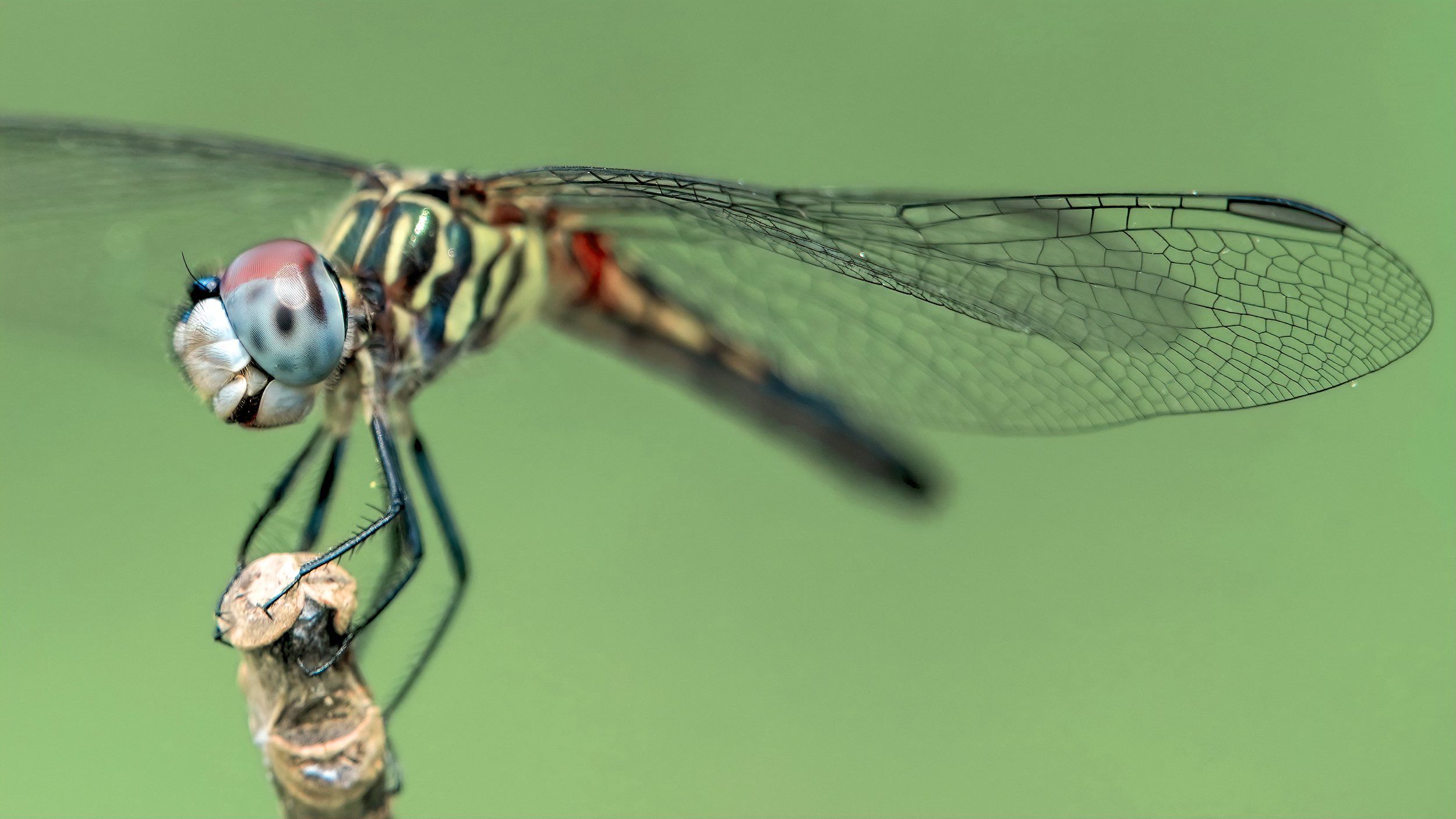Ok, you can’t exactly ask them to lower their chin and turn to the right; however, they also don’t complain about hair and make-up or 6 a.m. shoots. And they work unknowingly, for sugar water, or even safety.
You’ll be surprised at how much posing you can get out of your new bug buddies, especially the grateful rescues and the naturally curious species. What?! Grateful?! Insects don’t have emotions! Well, I can’t say for sure because I’m not an insect, but it turns out that scientists don’t exactly agree on the matter.
What I do know is that the insects I’ve rescued from certain death, usually via drowning, “appear” to become trusting and grateful. I know initially they are in shock and may not be able to leave due to water weight and other factors. However, by the time they regain their composure, they seem to also gain trust.
Or, it’s survival instinct like prison and they’ll take whatever protection they can get. Nature is brutal, even more so when you’re tiny. All I know is that I’ve had many a feral insect pet (they are domesticated) that won’t leave me when “released.” Being the bug equivalent of grubhub doesn’t hurt either. But hey, do our dogs really love us for any reason other than providing protection and food?
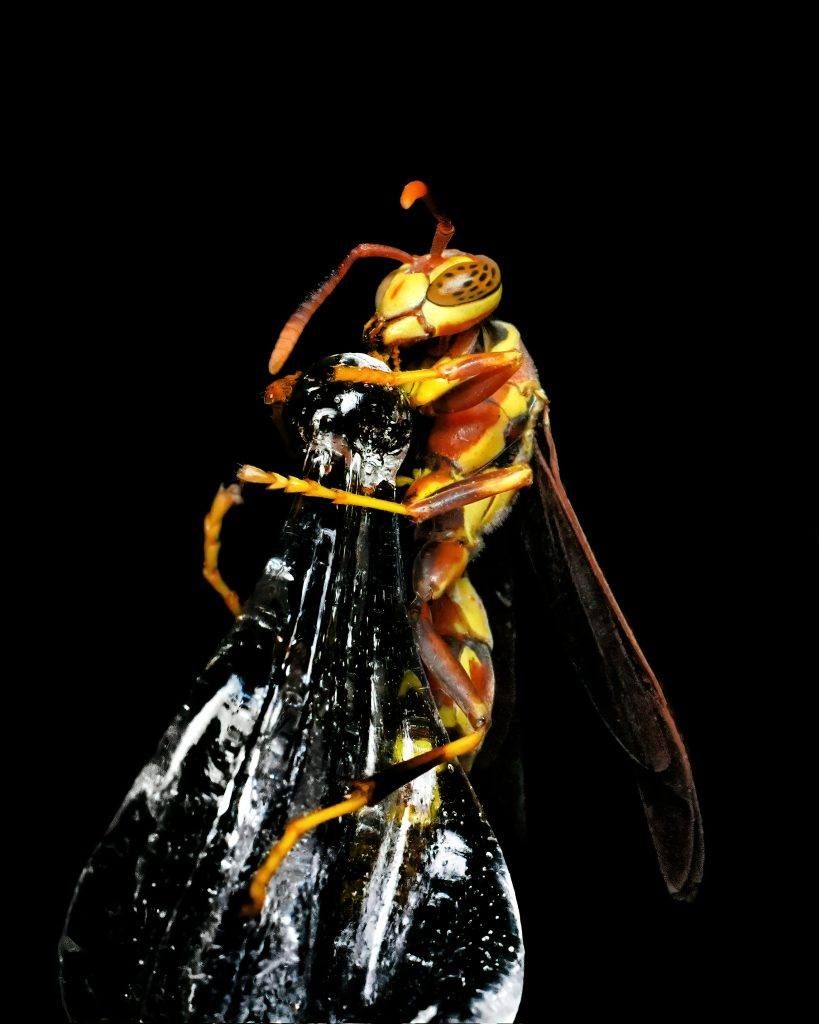
A wasp brought in from the cold and fed sugar water became my docile and affectionate pet for the day, even rubbing his/her head against my finger like a purring kitten. Photograph by Lynne Guenther
In this article (the second in a series on insect photography), we’ll discuss the who, where, and how of insect photography.
- Categories of easy subjects: the rescued, the curious and repetitive, the young and naive, the oblivious worker, the slow, the cold, and the pet
- Where to rescue insects
- Techniques for capturing insects
- Baiting insects
- Buying or raising insects
- Humane treatment and environmental responsibility
Recommended Reading: If you’d like to improve your composition skills for better images, grab a copy of Photzy’s best-selling premium guide, Advanced Composition.
Model Behavior
Our flying friends like wasps, dragonflies, and flies are curious by nature and often like to cock their heads like puppies, which kind of is like saying “lower your chin and turn to the right.” Plus, they have predictable repetitive flight patterns that can be studied.
Nymphs, or newborn insects that don’t change much over time other than size – such as the assassin bug, praying mantis, and cicada – are curious due to their youth and naivety. The hard-working ants and busy bees rarely notice your presence. Pro tip: bees nap in flowers throughout the day while hugging in pairs and make adorable sleeping subjects.
Our flying friends like wasps, dragonflies, and flies are curious by nature.
There’s a variety of species that move slowly in general, such as ladybugs, stick bugs, and caterpillars. When handling centipedes and millipedes, a quick internet search is necessary since some species can have a nasty bite, as with spiders and assassin bugs.
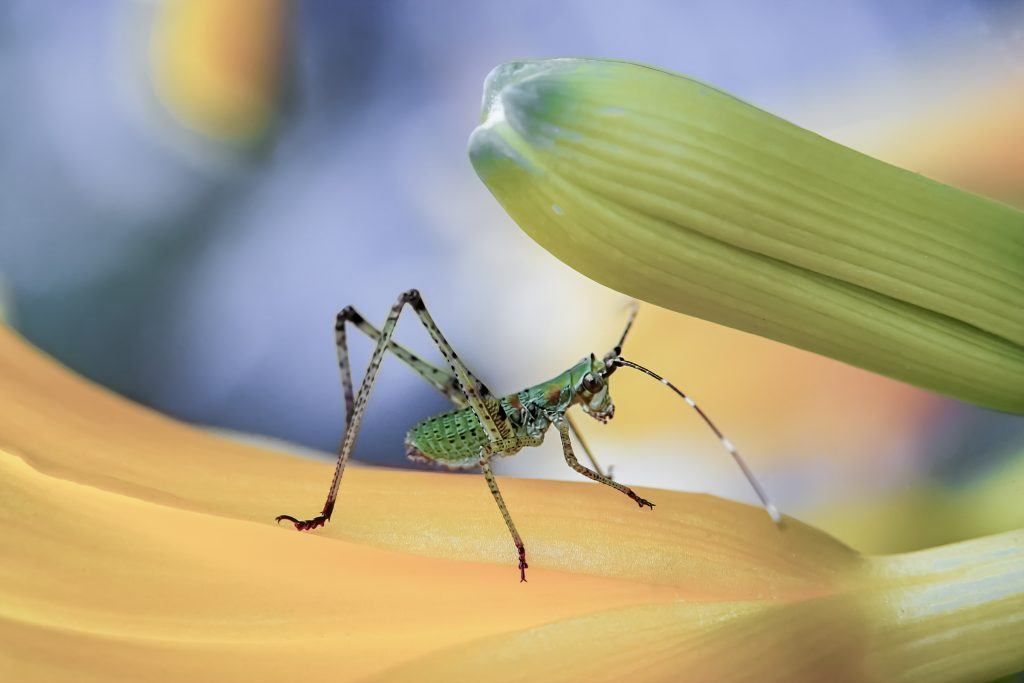
As adults, katydids are solid in color resembling a fresh green leaf. But as nymphs, they are much more colorful and interesting subjects. Photograph by Lynne Guenther
Almost all insects, minus beetles, tend to get significantly slower when cold. Because of this, some photographers place their subjects in the freezer. We will discuss this later, but for now I’ll say that the last 2-3 weeks of autumn are my favorite time to work with insects because nighttime temperatures can reach 50°F. But daytime temperatures are warm enough to keep them from hiding, hibernating, or expiring.
With short warm days and cool evenings, I choose studio portraits over nighttime flash environmental, but that is an option as well. However, remaining outdoors will mean little to zero activity from your subject. Since activity is generally more interesting, I prefer to bring them indoors and shoot while they warm up.
Under constant LED lights, they’ll be warm enough to become difficult subjects in 3-5 minutes but active almost immediately. Longer working times are achieved with the use of flash, but the timing of activity becomes unpredictable without a constant nearby heat source.
Key Lesson: Most insects are curious enough to stay or return when you aren’t flailing your arms about. People all over the world have been breeding and keeping insects as pets for centuries (beetles, spiders, moths, and praying mantises are all popular). Cold insects move slower, the best subject are rescues, and FACIAL EXPRESSION MAKE THE IMAGE.
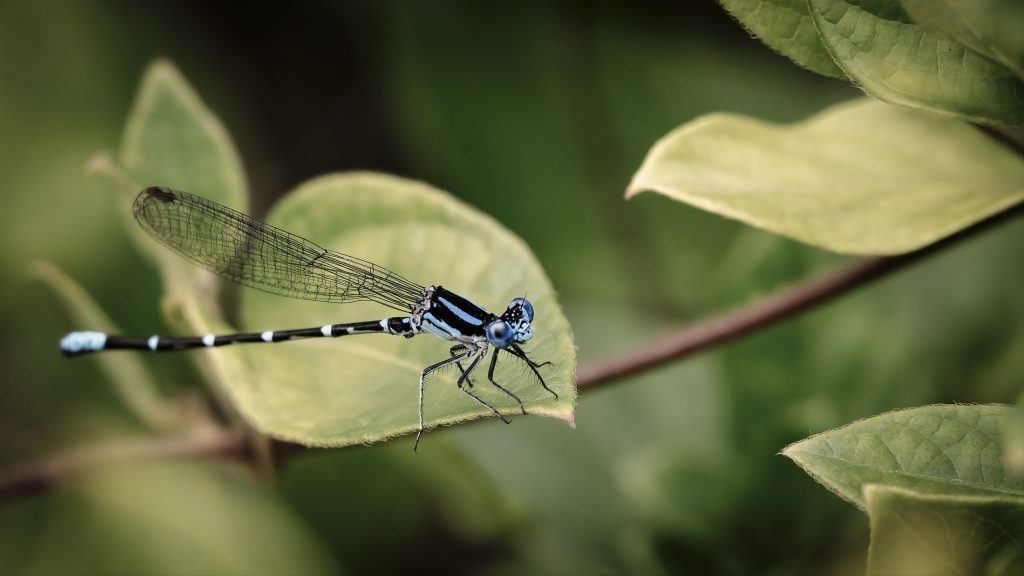
Pro tip: Although you want to be quiet approaching and setting up the shot, once I have a few “back-ups” I make a sharp and fairly loud clicking noise so the subject faces the lens with an emotional facial expression. This is how I coaxed the pose in the cover photo. But sometimes you just capture a moment through patience like this damselfly jumping leaves. Photograph by Lynne Guenther
Casting Calls
There are many techniques and devices for capturing various types of insects, but I’ve found that just three techniques will provide for the majority of species: aquatic nets, beating sheets, and sugar water baiting. My favorite way of obtaining subjects is to rescue those trapped by water. Many flying insects get a little too close to the water, and once a wing is wet there’s no escape without human intervention.
Three techniques will provide for the majority of species: aquatic nets, beating sheets, and sugar water baiting.
Simply travel to your nearest body of water: a pool, pond, fountain, puddle, or even water rushing to the gutter in a rainstorm. Place your aquatic net in the stream for 15-30 seconds at a time checking for insects and placing them in containers. For still bodies of water, keep your eyes peeled and scoop out what you see. They take 10-15 minutes to recover from shock once removed from the water source.
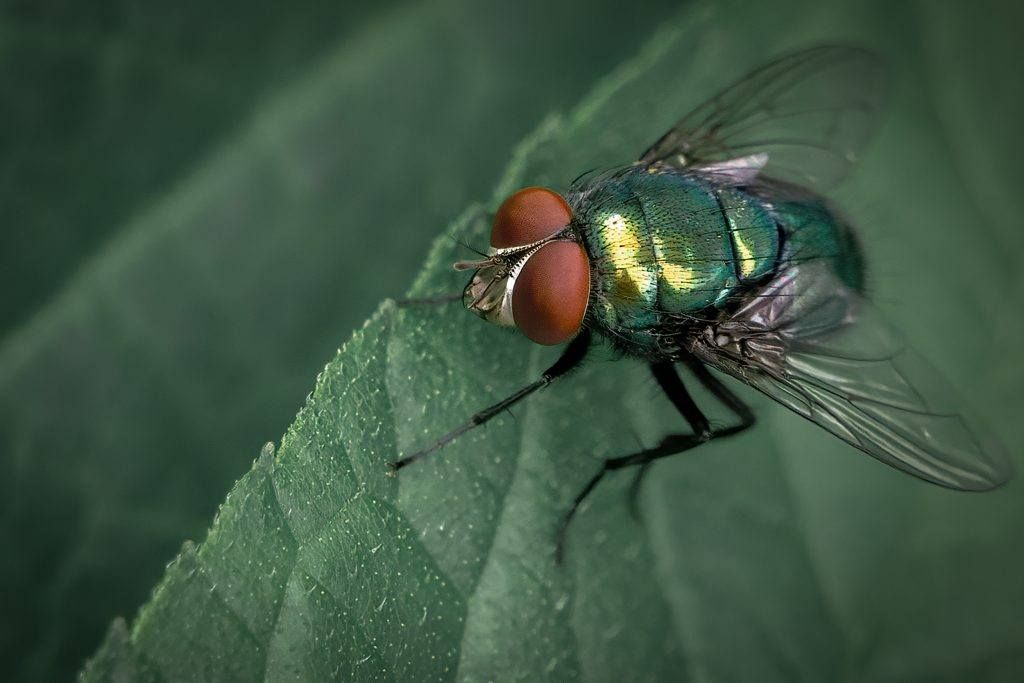
Blow fly. Photograph by Lynne Guenther
This is an excellent time to hold them, even stroke them lightly with your finger, providing comfort and warmth. As the insect becomes more active, provide a drop of sugar water or even fruit juice or syrup. I find bonding through touch and feeding keeps some insects from leaving after they’ve recovered, allowing for hours of uninterrupted shooting and handling for control over composition.
Beating sheets are simply white fabric secured to two crossed rods so that the entomologist (bug worshipper) can hold the rods, allowing the white fabric to catch insects that fall from bushes, trees, and other plants as they are beaten with a third rod or shaken to release the insects. A white umbrella upside down can work as well. Just stick with light colors so that you can see the specimens as they fall.
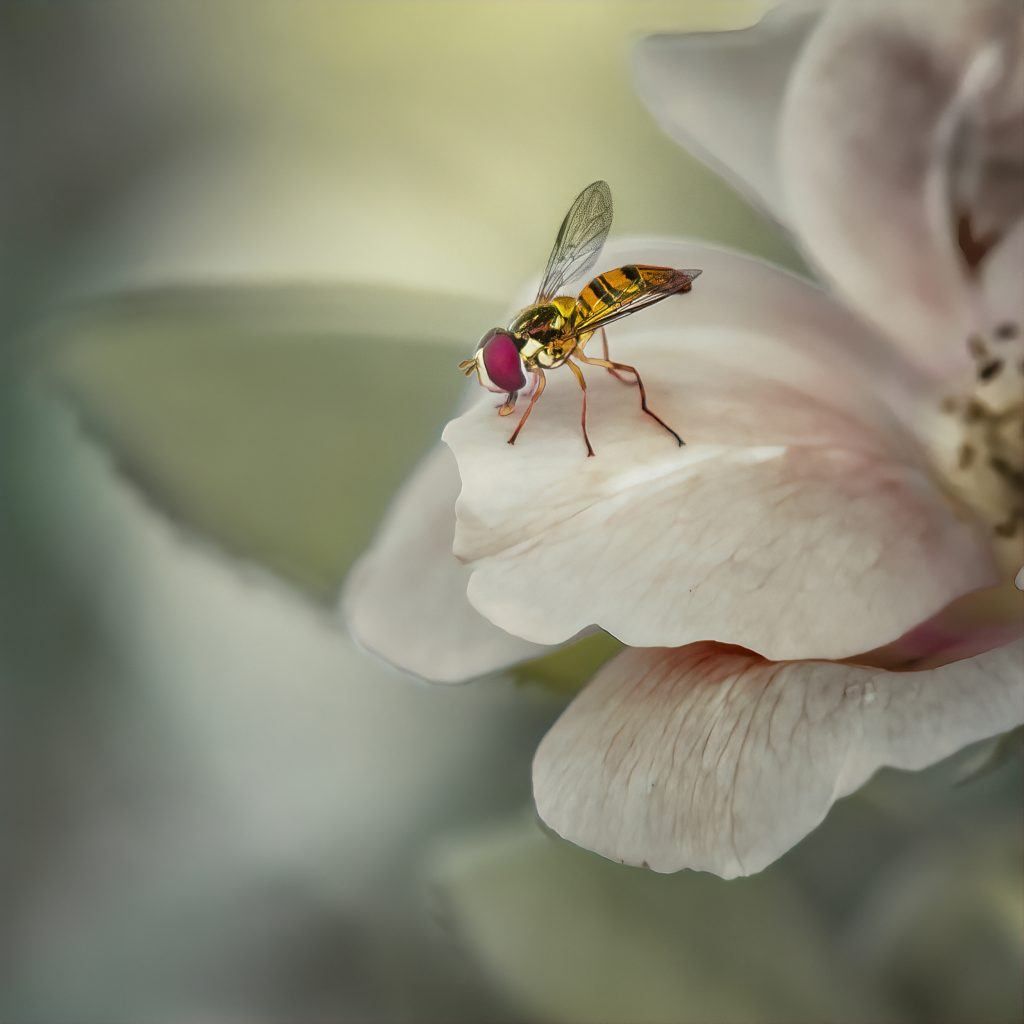
Flower fly. Photograph by Lynne Guenther
Both of the methods I’ve mentioned require placing the specimen in either a studio or natural environment after collection; however, the third option, baiting, can be done so that contact is never made. Simply spray sugar water on the items you would like the subject to rest on. This will place them where you want as well as keep them there for several minutes without contact. Even if all you catch are flies, flies come in a variety of species with differing shapes, sizes, and colors. They make wonderful subjects once you see them at a macro level.
Key Lesson: Insects can be found in water, bushes, or plantes, or they can be coaxed to you with bait.
Recommended Reading: If you’d like to improve your composition skills for better images, grab a copy of Photzy’s best-selling premium guide, Advanced Composition.
Ethical Responsibilities
There is a fourth way I obtain insects, but it comes with a great deal more responsibility: purchasing and raising. For captured insects, they can simply be returned to their environment, but those purchased should rarely be released – the reason being ecological balance. (However, monarchs are great for raise and release.)
Many photogenic caterpillars and moths, like the hornworm or hawkmoth, are invasive crop pests. Releasing them can have major impacts on the environment. This species stays in the caterpillar form for one month, the pupa form for three months, and, if well cared for, another month as a moth. Some beetles and praying mantises live 1.5–3 years and make excellent pets but come with responsibilities similar to caring for lizards.
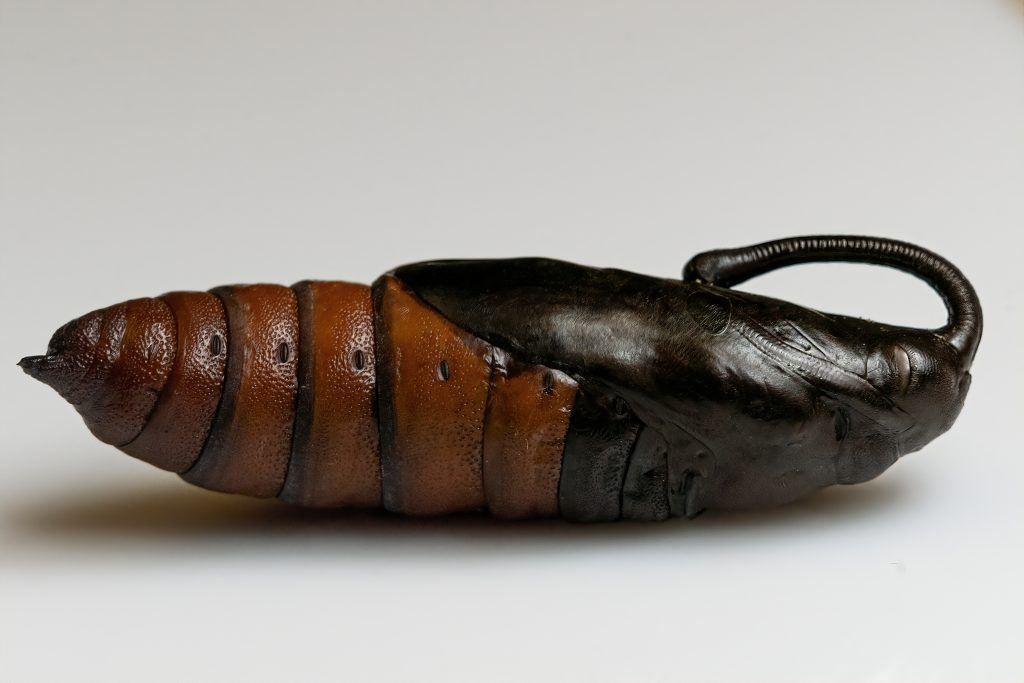
Hawkmoth pupa, final stage. I’m saving his beautiful caterpillar stage for an upcoming guide on studio insect photography. Photograph by Lynne Guenther
Not everyone can take the time, effort, and money to raise and bond with their subject, but still want an easily controlled subject for studio work. This has led to many discoveries such as ants hating vinegar and being unwilling to step in it. Simply place a platform for the ant in a bowl of vinegar and he’s contained as long as needed. Because the fumes clearly bother the ants, I prefer to draw a line around them, they think it’s a barrier… yes, just a marker or pen line.
Others use acetone or freezing to sedate their subjects to an unconscious level. I oppose these methods outside of the use of them by trained entomologists due to the ease of accidental death of the subject. Neither is uncomfortable for the insect if done properly; however, logistically for photography, it causes more work than it is worth.
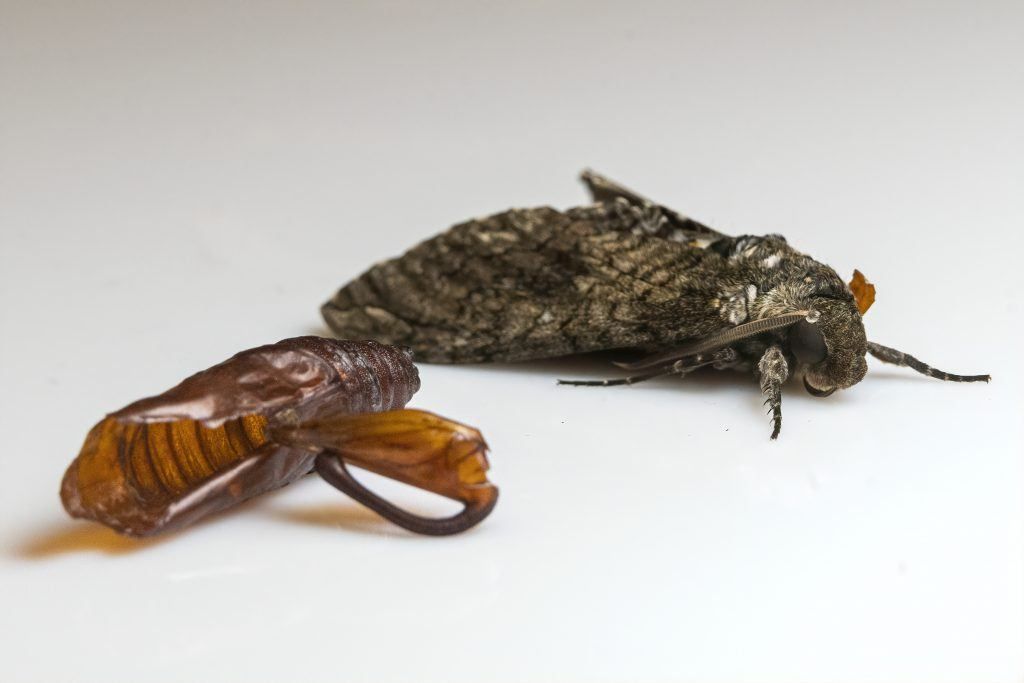
Right after finishing this guide, I discovered my new furry friend Mr. hummingbird moth, a.k.a. the hawkmoth, had emerged. Quite exhausted, I left him be after a quick snap. Photograph by Lynne Guenther
For one, insects become dirty very quickly from tiny dust particles constantly landing on them. They groom meticulously and frequently. After being unconscious for a few minutes they become very dirty and less attractive. They require quick and difficult physical cleaning using tweezers and cotton swabs before waking. Also, if cooled, they take on a dull color and film-like appearance identical to the first wasp photo in this guide.
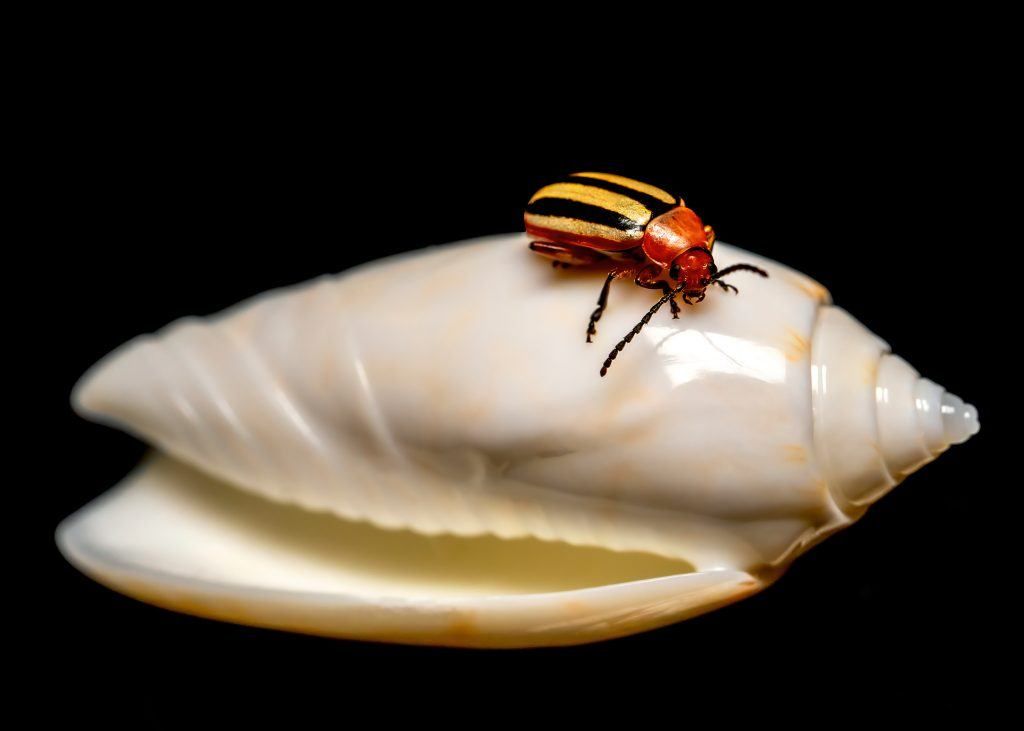
This flea beetle was rescued from a pool skimmer and can jump up to 4 feet in a split second, which he did many times. Pro tip: Some of the cutest beetles like flea, potato, and cucumber are the fastest (impervious to the cold) and most difficult to work with, although their striking patterns and colors are worth the effort. Photograph by Lynne Guenther
Key Lesson: Although easier than a puppy, caring for insects still requires time, money, and effort. Hand-raising is the best way to get easily controlled subjects; cold or rescued is second. Think twice about sedation as there is a fine line between sleep and death. With time and practice you can shoot the most difficult of subjects in minutes without greatly disturbing their comfort.
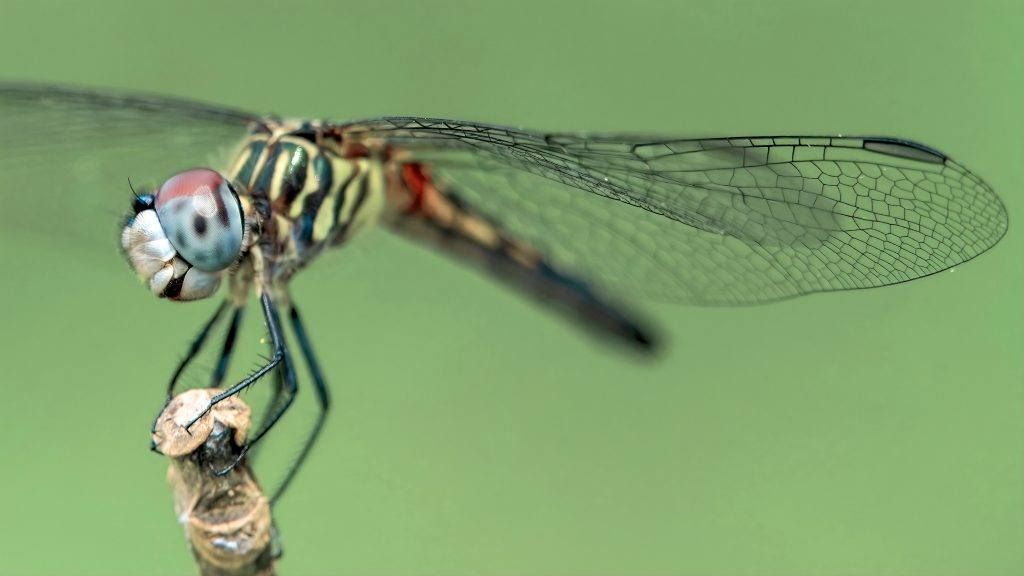
Photograph by Lynne Guenther
Conclusion
Self-Check Quiz:
- Do you wear gloves while handling insects?
- If you want to pay your models, what is their favorite currency?
- Can some insects be pets?
- Why do ants hate vinegar?
- What is the biggest trap for winged creatures?
- What is a beating sheet?
- Why are dead or unconscious insects not as photogenic?
- How long do insects take to recover from shock?
- What is working time?
- What is a nymph?
Assignment:
- Shake a bush with a beating sheet underneath and see what you get.
- Rescue, feed, and bond with an insect saved from water.
- Bait and insect.


